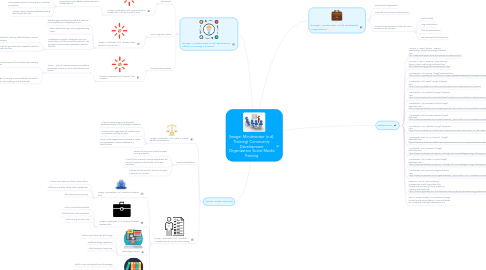
1. (Image: Mindmeister. (n.d). Business & Office) Learning Theories
1.1. Behaviorist
1.1.1. (Image: Mindmeister. (n.d). Spinner) Burrhus Frederic (B.F.) Skinner (McLeod, 2007)
1.1.1.1. “Operant conditioning” Theory Using positive and negative reinforcement to modify behavior.
1.1.1.1.1. Relates to Training: Using the positive reinforcement during Customer Service Training gives a positive influence for mandatory training.
1.1.1.1.2. Show positive results of training from Customer perspective
1.1.1.1.3. Positive impact provides staff better feeling about doing their job.
1.2. Social Cognitive Theory
1.2.1. (Image: Mindmeister. (n.d). Spinner) Albert Bandura (McLeod, 2011)
1.2.1.1. Bandara agrees with Behaviorists but adds two more key theories, integrating the SCT.
1.2.1.2. Observational learning: learning by observing others
1.2.1.3. Mediational Processes: Individuals don’t just watch others and then are able to perform. The individual must have the capability to perform the skills
1.2.1.3.1. Relates to Training: Staff will observe correct behavior
1.2.1.3.2. Staff will gain skills to be capable to perform with accuracy
1.3. Transformative learning
1.3.1. (Image: Mindmeister. (n.d). Spinner) Jack Mezirow
1.3.1.1. Theory: When an learner’s experience creates a meaningful mind set, such as with behavior and beliefs.
1.3.1.1.1. Three dimensions of the transformative learning theory
1.3.1.1.2. Relates to Training: Provide staff with the results of their work (adding value to their job).
2. Social Media Training
2.1. (Image: Mindmeister. (n.d). Scales of Justice) Ethical Considerations
2.1.1. All social media usage must follow the guidelines written in the employee handbook.
2.1.2. Social media usage does not violate a client or customer's privacy or rights
2.1.3. Social Media usage does not disrupt or violate the organization's mission statement or ethical values.
2.2. Social media Effects
2.2.1. Trainers will use social media to create training programs
2.2.2. All staff of the Customer Service Department will use social media to interact with clients and customers.
2.2.3. Staff will review and train from social media tools such as YouTube.
2.3. (Image: Mindmeister. (n.d). Checklist) Competencies for Social Media Training
2.3.1. (Image: Mindmeister. (n.d). Personnel) Personal skills
2.3.1.1. Staff's current personal skills, values, ethics
2.3.1.2. Staff personal skills, values, ethics capabilities
2.3.1.3. After training accuracy 90%
2.3.2. (Image: Mindmeister. (n.d). business-suitcase) Business skills
2.3.2.1. Staff's current business skills
2.3.2.2. Staff business skills capabilities
2.3.2.3. After training accuracy 95%
2.3.3. Technology Literacy
2.3.3.1. Staff's current skills with technology
2.3.3.2. Staff technology capabilities
2.3.3.3. After training accuracy 95%
2.3.4. Industry Knowledge
2.3.4.1. Staff's current industry skills and knowledge
2.3.4.2. Staff industry skills and knowledge capabilities
2.3.4.3. After training accuracy 90%
3. (Image: Mindmeister. (n.d). Briefcase) Organization
3.1. Not-for-profit organization
3.2. Helps the local county provide services
3.3. Connect those persons in need with social workers or case workers
3.3.1. mental health
3.3.2. drug rehabilitation
3.3.3. food supplementation
3.3.4. Job Training/Skill development

